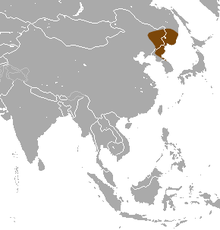Ussuri shrew
The Ussuri shrew (Sorex mirabilis), also known as the giant shrew,[3] is a species of shrew found in Northeast Asia. An adult Ussuri shrew has a total length including the tail of 137 to 170 mm (5.4 to 6.7 in). It is found in valleys and on the forested slopes of mountains in the Korean Peninsula, northeastern China, and the Russian Far East. It is rarely observed, and its ecology is largely unknown.[4]
| Ussuri shrew[1] | |
|---|---|
| Scientific classification | |
| Kingdom: | Animalia |
| Phylum: | Chordata |
| Class: | Mammalia |
| Order: | Eulipotyphla |
| Family: | Soricidae |
| Genus: | Sorex |
| Species: | S. mirabilis |
| Binomial name | |
| Sorex mirabilis Ognev, 1937 | |
 | |
| Ussuri Shrew range | |
Description
This is the largest shrew in the genus Sorex and grows to a head-and-body length of 74 to 97 mm (2.9 to 3.8 in) with a tail of 63 to 73 mm (2.5 to 2.9 in). The hind foot is 16 to 18 mm (0.6 to 0.7 in) long and the weight is 11 to 14 g (0.4 to 0.5 oz). Both the dorsal pelage and the underparts are iron grey.[5] The large size, robust tail and various details of the dentition help to distinguish this shrew from other species.[3]
Distribution and habitat
The Ussuri shrew is native to northeastern China, northeastern Korea and southeastern Russia. It inhabits both broadleaf and mixed coniferous/broadleaved forests in valleys and on hillsides, and is present on mountains in South Korea at altitudes of over 1,500 m (5,000 ft). It prefers moist locations and also occurs in marshes at higher altitudes.[2][3]
Ecology
The Ussuri shrew is a terrestrial species and creates burrows. Although it also eats insects, other invertebrates and carrion, about 82% of its diet consists of earthworms, and because of their relatively low nutritional value, it needs to eat more than twice its bodyweight each day.[3][5] It is presumed to nest underground but its breeding habits are little known. There is normally one litter per year and by August, the young are sometimes caught in traps. A second litter may be born when circumstances permit, and the young become sexually mature at 11 months of age.[3][5]
Status
The International Union for Conservation of Nature does not have enough information on this species to rate its conservation status, and has listed it as being "data deficient". However, the Ussuri shrew has a wide range and, despite being a rarely seen and poorly known species, when more information becomes available, it may turn out to be of "least concern".[2]
References
- Hutterer, R. (2005). Wilson, D.E.; Reeder, D.M. (eds.). Mammal Species of the World: A Taxonomic and Geographic Reference (3rd ed.). Johns Hopkins University Press. p. 292. ISBN 978-0-8018-8221-0. OCLC 62265494.
- Clayton, E. (2016). "Sorex mirabilis". The IUCN Red List of Threatened Species. IUCN. 2016: e.T41404A22313688. doi:10.2305/IUCN.UK.2016-1.RLTS.T41404A22313688.en. Retrieved 30 March 2019.
- Jo, Yeong-Seok; Baccus, John T.; Koprowski, John L. (2018). Mammals of Korea. National Institute of Biological Resources. pp. 74–76. ISBN 978-89-6811-369-7.
- Won, Byeong-o (원병오) (2004). 한국의 포유동물 (Hangugui poyudongmul, Mammals of Korea). Seoul: Dongbang Media. ISBN 89-8457-310-8.
- Smith, Andrew T.; Xie, Yan (2013). Mammals of China. Princeton University Press. p. 208. ISBN 1-4008-4688-9.
